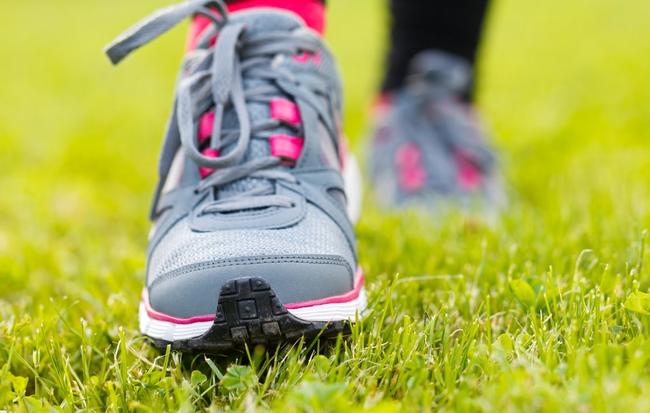Need to exercise more? Start with one of the easiest, healthiest activities around: walking. Walking may seem like too simple of a fix when it comes to exercise, but it has incredible health benefits, you can build up your speed over time to get great cardio, plus being on the move will probably make you happier.
All you need is to do is keep a comfortable pair of walking shoes handy, and start making it a habit to get a walk in daily. You can set your alarm a bit earlier to wake up and get a walk in at sunrise, or throw a pair of walking shoes in your car, and leave an extra pair to your office, so you can take a brisk walk at lunch anytime you have the opportunity.
Walking is the easiest form of exercise to stick with, says the American Heart Association. And a simple 30-minute walk every day of your workweek not only makes it easy to get those recommended 150 minutes of exercise per week, but it also wards off the symptoms of menopause, according to a Canadian study. Here are a 5 tips to put your best foot forward.

Grab comfortable shoes
Nothing can kill your motivation to exercise like blisters or sore arches, so if you don’t have walking shoes that fit properly, it’s worth a splurge. Plus, sometimes buying a cute new pair of walking shoes, sneakers, or joggers can be the inspiration you need to get you out the door.
But before reach for the credit card, be sure to check your closet. Any comfortable, properly fitting pair of cross-trainers or sneakers will work to start walking right away. However, if you find yourself without even an old reliable pair, make sure to buy shoes that fit both your foot and your body size. You can go into a running or fitness store to get your feet measured and your gait analyzed, and they can easily help you buy a supportive shoe that’s made for walking, and made for your feet.

Pick your favorite route
A nearby park or walking trail can do double duty, providing you with a safe place to walk while also giving you a nature fix, which has been shown to lower stress and keep you happy.
If there’s no park nearby, use Google Maps, which now has a walking feature, to plan your route, or consult the U.S. Track and Field Association’s America’s Running Routes tool. Though designed for runners, you can map out your own walking route or even find one that other walkers have tried and liked.

Recruit a pal
If you like to chat while you stroll: recruit a friend or coworker to join you on a “walking lunch,” starting once a week (Mondays are the best day to start a new habit, according to research from The Monday Campaigns). If you’re more of an early morning bird, invite a friend to meet you for a sunrise (or just before work) walk once a week, so you’ll both be motivated to stick to it, and have some company.
If you like to go solo: plan a walk in the early morning when you don’t have other commitments, or on your lunch break. It’s been shown repeatedly that making time to be outside getting fresh air and taking in nature is intrinsically beneficial to your health and motivation, so going solo or with a group is equally helpful.
If you like a beat: make sure you bring along some good exercise music to keep you moving at a quick tempo. To walk at a pace of four to five miles per hour, it helps to have music with about 120 to 135 beats per minute. Or just find a song with a fast chorus and a slower verse so you can do some interval training during your walk. Keep it at a low enough volume that you are still aware of what’s going on around you.

Stretch it out
Conventional wisdom used to state that stretching before and after your workout was necessary. But now, exercise physiologists agree that just stretching afterwards will help you maintain flexibility without hurting your muscles. Try these yoga poses after you walk, or do these easy hand stretches in your office chair. You can also try to get the whole office to join in an afternoon stretch break once a week, and add it to your calendar to keep yourself accountable.

Keep moving all day
Even for regular exercisers, sitting for prolonged periods can encourage weight gain and lead to problems like blood clots in the legs. Try moving around for 10 minutes every hour throughout your day, whether it’s simply standing up while you talk on the phone, walking up and down the stairs for a few minutes to clear your head, or delivering a message to a colleague on foot rather than sending them an email.













